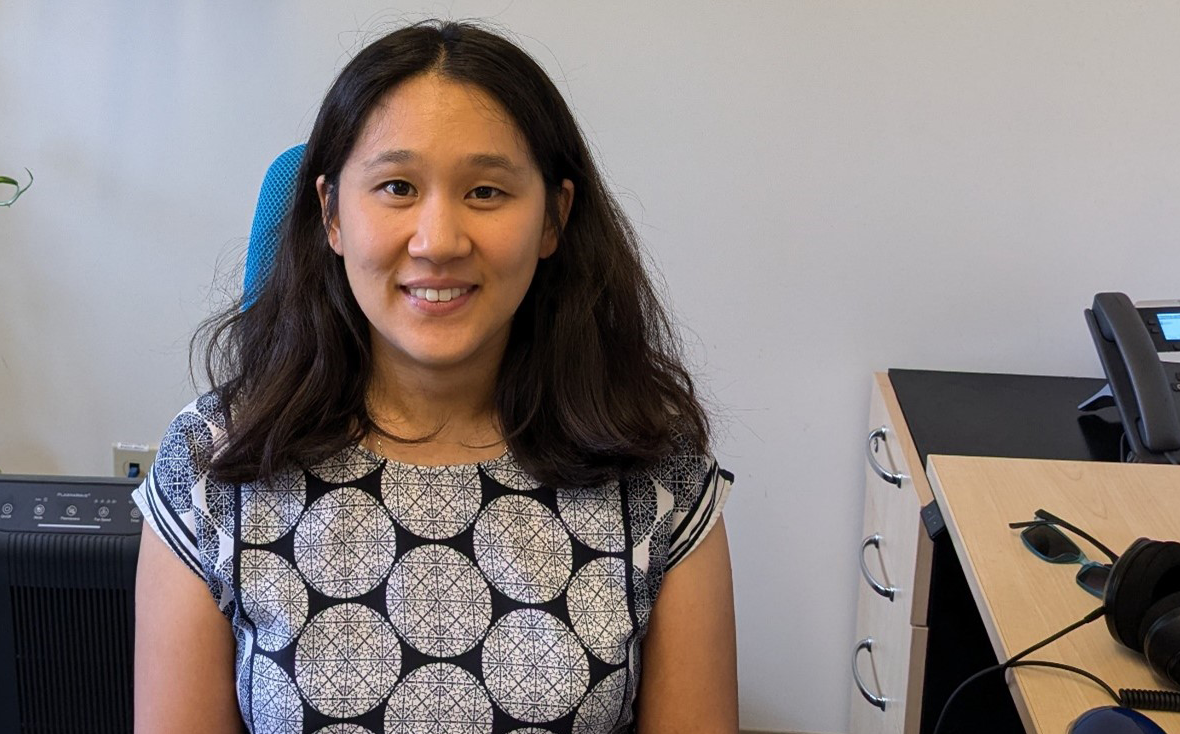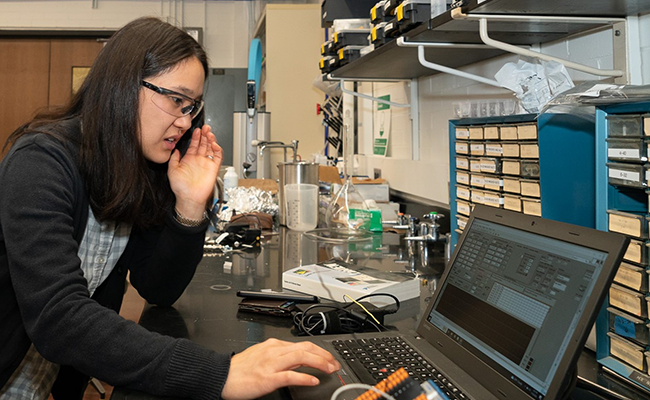A Pennsylvania researcher builds and tests a novel device for measuring the precursor gases in seed-particle formation

It has been said that the Earth has two oceans. One is combined from the expansive salty seas that cover 70% of the planet. The other ocean is the atmosphere, where vast decks, wisps, and puffs of clouds are the chief visible signs of Earth’s water cycle—a continuous surface-to-sky-to-surface exchange of water in the form of vapor, liquid, and ice.
All the clouds rolling and folding above us contain a big fraction of the atmosphere’s water. So, it is useful to ask how clouds are made.
Welcome to the research world of Coty Jen, an associate professor of chemical engineering at Carnegie Mellon University in Pittsburgh, Pennsylvania. Among other things, she is interested in precursor gases that evolve (“nucleate”) into the seed-like particles needed for cloud droplet formation. Worldwide, this process of atmospheric nucleation generates 50% of the particles that condense into clouds.
However, the chemical and physical mechanisms of how new particles become aerosols remain an uncertainty in models that simulate a changing climate. Aerosols are tiny atmospheric particles (hybrids of gases, solids, and water) that make clouds and precipitation possible.
Some clouds gather in decks thousands of miles wide. But the gases from which they grow are tiny—as little as 1 angstrom across. That’s the width of an atom.
“I don’t know if I’m helping the planet. But I Iike to think we are understanding how it’s changing in some way, creating knowledge to adapt, and developing technology to address problems.”
– Coty Jen
Most precursor gases, says Jen, are a little larger, though still “as small as two molecules huddled together.”
Spotlighting Sulfuric Acid
Jen’s primary research target is sulfuric acid, the most prominent of the precursor gases that initiate cloud-forming particles. Challengingly, nucleation reactions take place at very low concentrations of precursor gases—so low that sometimes they are only measurable in parts per quadrillion. (Carbon dioxide, an atmospheric gas everyone has heard of, is measured in parts per million.)
At the same time, other gases either enhance or suppress sulfuric acid nucleation. These compounds are so diverse (water, amino acids, oxidized organics, and more) that they further complicate attempts to model nucleation. (Jen has even studied the role of compounds like ammonia from penguin “emissions” in the Southern Ocean.)
She leads a Carnegie Mellon laboratory group looking for ways to observe, measure, and model atmospheric nucleation driven by sulfuric acid.
To this end, Jen is principal investigator in a 2021-2025 project funded by the Atmospheric System Research (ASR) program at the U.S. Department of Energy (DOE).
In the Field

The field portion of Jen’s ASR investigation, in May and June 2024, was a small ARM campaign called Vertically Resolved Nucleation Precursors at SGP (VRNPS).
For VRNPS, she made two basic decisions. One was to conduct the work at the Central Facility of the Southern Great Plains (SGP) atmospheric observatory in Lamont, Oklahoma. SGP has 50 core surface instruments operated by Atmospheric Radiation Measurement (ARM), a DOE Office of Science user facility.
The other decision was to deploy some custom instrumentation aboard an ARM tethered balloon system (TBS). Tethered balloons were an ideal platform for Jen’s mission to sample the gas precursors of particle nucleation. Such balloons, strung with small instruments like paper lanterns, operate at altitudes up to about 1,000 meters (3280 feet). That’s high enough to examine atmospheric conditions at the base of some clouds.
The operational limitations of TBS (instruments must be light and compact) fit right in with one of Jen’s key ASR ambitions—to develop a device for measuring atmospheric sulfuric acid that is compact, research-grade, medium-cost, and easy to power up.
At SGP in 2023, one member of Jen’s group, chemical engineering PhD student and National Science Foundation (NSF) Graduate Fellow Dominic Casalnuovo, briefly tried out a prototype of the novel measurement technique aboard a TBS. Jen called it “a very low-stakes deployment” that revealed a few problems.
Her team tried again (with better success) in June 2024, when the final prototype went aloft.

Counting Particles
The custom instrument from Jen’s lab is a reactive condensation particle counter. It’s about the size of a lunchbox, with a thermos-shaped nucleation flow reactor that measures concentrations of sulfuric acid. The counter is designed to minimize the effects of high relative humidity, which can suppress particle formation.
Chongai Kuang, an atmospheric scientist and aerosols researcher at Brookhaven National Laboratory, helped develop the particle counter for TBS flights and was at SGP to conduct complementary measurements of freshly formed particles aloft.
In the GIF (guest-instrument facility) at SGP, Jen’s team set up larger instruments for measuring particle sizes and characterizing gas and particle chemistry.
Back home in Pennsylvania, the team is using their SGP data to test a nucleation potential model designed to predict nucleation rates even in the world’s chemically complex atmospheric systems. The model addresses one big challenge: Sulfuric acid combines with many other compounds linked to different rates of nucleation, all of which vary regionally across the world.
A Utility Knife, Please

Jen grew up in suburban Wisconsin, captivated early on by the idea of building things. At age 4, she remembers asking her father for a utility knife. All the better to make house dioramas and three-dimensional (3D) models of all kinds.
By middle school, “I was super into 3D modeling and CNC (computer numerical control) milling,” as well as working with wood, says Jen. Later, during a collaborative product design class in high school, she did all the model work and machining.
Given such interests, naturally, one early dream was to become an architect—and even today “every so often I would still like to do that,” says Jen.
Instead, before applying to colleges, she embraced the idea of engineering, her father’s profession. “It’s very broad,” says Jen, with plenty of opportunities for building things.
By the time Jen enrolled at Columbia University (B.S. Chemical Engineering, 2010), she had acquired a newfound fascination with the chemistry of long-chain polymers. Undergraduates are expected to join a research team, but Jen hit a dead end with the polymer chemistry faculty.
“I am fortunate enough to find almost everything interesting.”
– Coty Jen
“No one wrote me back,” she says.
But then the magic happened: V. Faye McNeill, a new faculty member starting an atmospheric chemistry laboratory from scratch, needed a student who was a woodworker, too.
Bingo.
“I got to build all this stuff,” says Jen, “and learn about cool instrument principles.”
As for switching to atmospheric science, “no one had to persuade me,” she says. “I am fortunate enough to find almost everything interesting.”
Locked into Aerosols
At the University of Minnesota-Twin Cities (M.S. Chemical Engineering, 2013; PhD Mechanical Engineering, 2015), Jen joined an aerosol group when her doctoral work began. Her dissertation contained the seeds of the research she loves to do now: a mass spectrometry investigation of sulfuric acid and links to nucleation processes in the atmosphere.
In 2015, Jen joined the University of California, Berkeley, as an NSF postdoctoral research fellow, digging into speciating organic aerosols in the Amazon Rainforest and characterizing fresh and aged emissions from biomass burning events. (The evolution of aerosols in the atmosphere is called “aging.”)

At the time, Jen briefly considered shifting away from research on aerosols, “but I’m locked in now,” she says. “It worked out well.”
As a faculty member at Carnegie Mellon, which she joined in 2018, Jen brings a shade of her younger, build-happy self.
Her group often focuses on making instruments robust enough for field deployments in rugged places and sensitive enough “to understand the (atmospheric) processes happening there,” says Jen.
She credits her husband, a climate modeler, with inspiring much of her own instrument design. For that, she has to counter the hard realities of most laboratory instruments: They are large, expensive, “and crazy power-intense,” says Jen, who has tried to leverage her ASR project to develop a small, battery-powered, field-ready device for measuring sulfuric acid and its behavior in the upper boundary layer.
Meanwhile, “I don’t know if I’m helping the planet,” says Jen. “But I like to think we are understanding how it’s changing in some way, creating knowledge to adapt, and developing technology to address problems.”
Those planetary changes rely on the fine details of precursor gases, particle nucleation, and other data to explain what happens in the atmosphere.
“How can we come up with effective engineering technologies for climate change,” Jen asks, “if we don’t understand the fundamental ways the atmosphere is behaving?”
# # #Author: Corydon Ireland, Staff Writer, Pacific Northwest National Laboratory
This work was supported by the U.S. Department of Energy’s Office of Science, through the Biological and Environmental Research program as part of the Atmospheric System Research program.

